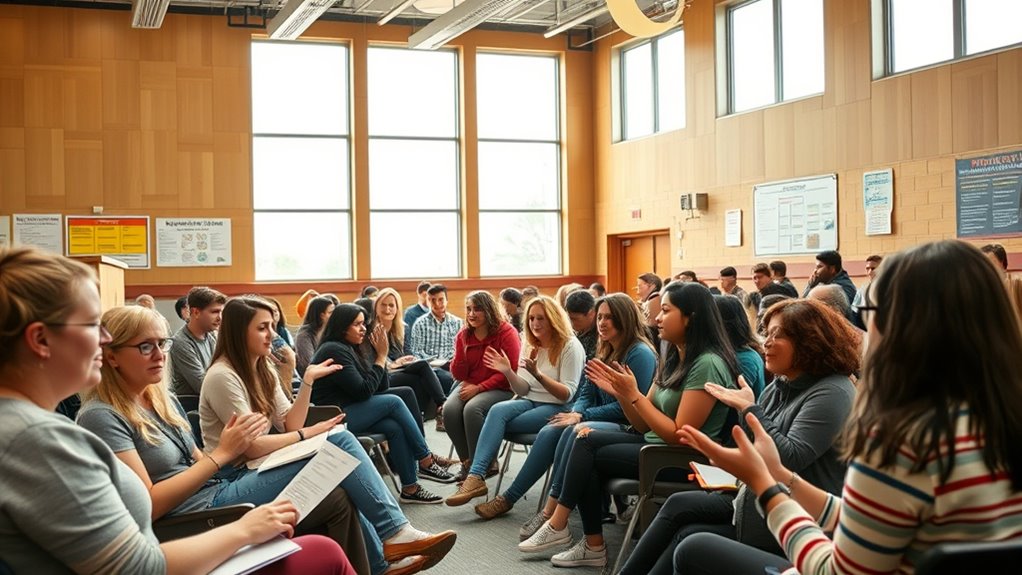Transition planning for deaf high school seniors helps you confidently move into independence by focusing on your communication needs, exploring careers, and developing everyday skills. It’s important to understand available resources, use assistive technologies, and build support networks that match your goals. Planning ahead smooths your progression and boosts your confidence. If you want to learn more about creating a personalized plan, keep exploring ways to prepare for life after high school.
Key Takeaways
- Develop a personalized transition plan emphasizing independence, employment, and accessible living options.
- Identify strengths, interests, and career goals early to guide job exploration and skills development.
- Ensure communication needs are clearly articulated and accommodations like sign language interpreters and captioning are secured.
- Build independent living skills such as budgeting, transportation, and healthcare management with community support.
- Leverage resources, mentorship, and support networks to facilitate a smooth and confident transition to post-secondary life.

Preparing for life after high school can feel overwhelming, especially for deaf seniors steering a complex shift. You’re likely thinking about the many steps ahead—finding job opportunities, living independently, and managing daily responsibilities. The shift isn’t just about finishing school; it’s about setting a foundation for your future. You want to be prepared to navigate new environments confidently, access resources, and communicate effectively. Understanding what to expect and planning ahead can make this process smoother and more empowering.
When it comes to job opportunities, it’s essential to identify your strengths and interests early. Think about careers that align with your skills and passions, and explore what qualifications or training you might need. Many employers value diverse perspectives and are open to hiring deaf professionals, especially if accommodations are in place. Research companies that prioritize inclusion and reach out to local job centers or employment agencies that specialize in supporting deaf individuals. Additionally, consider internships or volunteer roles to gain experience and build confidence. Developing a strong resume and practicing interview skills—possibly with the help of a job coach—can boost your chances of landing positions that match your goals.
Independent living is another pivotal aspect of your transition. You’ll need to learn how to manage household chores, budgeting, transportation, and healthcare. If you’re planning to move out of your family’s home, look into accessible housing options and support services available in your community. Many towns and cities offer resources tailored to deaf residents, such as communication-accessible housing or local support groups. It’s helpful to develop a budget and understand how to track expenses. Learning to use assistive technology—like visual alert systems or captioned devices—can make everyday tasks easier and foster your independence. Connecting with local organizations that support deaf adults can provide guidance, mentorship, and practical tips for living on your own. Additionally, knowing about home theatre projectors and their features can help you create a comfortable and accessible living space tailored to your preferences.
Communication will be a key part of your transition, whether you’re applying for jobs, managing a household, or accessing healthcare. Make sure your communication needs are clearly understood and accommodated. This might involve learning how to use sign language interpreters, captioning services, or other assistive technologies. Building relationships with professionals who understand your communication style can make a significant difference in your success and comfort.
Ultimately, your transition plan should be personalized and flexible. You’re not alone in this journey—resources, support networks, and community organizations are there to help you succeed. By proactively preparing for job opportunities and independent living, you’re taking essential steps toward a future where you can thrive on your own terms.
Frequently Asked Questions
How Can Families Best Support Deaf Seniors During Transition Planning?
You can best support deaf seniors by staying actively involved and using effective communication strategies. Engage in open conversations about their goals and needs, ensuring they feel heard. Attend meetings with school staff, ask questions, and advocate for appropriate accommodations. Your family involvement shows your support and helps your teen navigate their future confidently. Prioritize clear communication to build trust and empower your senior during this important progression.
What Technology Options Are Available for Deaf Students in Post-Secondary Education?
You can explore various technology options for deaf students in post-secondary education, like assistive devices and communication technologies. These include hearing aids, cochlear implants, real-time captioning, and video relay services. These tools help you access lectures, communicate effectively, and participate fully. Staying informed about the latest advancements guarantees you select the best solutions for your needs, enhancing your educational experience and independence.
How Do Employment Opportunities Vary for Deaf High School Seniors?
Imagine a world where employment opportunities for deaf high school seniors are as vast as the universe—yet, sadly, employment disparities still exist. You might find access to vocational training programs that can dramatically boost your skills and employability. However, challenges like communication barriers and limited awareness often hinder your chances. By advocating for better resources and inclusive practices, you can help bridge the gap and access a universe of career possibilities.
What Legal Rights Do Deaf Students Have During Transition Planning?
During changeover planning, your legal rights protect you from discrimination and guarantee you receive appropriate accommodations. Laws like IDEA require schools to provide tailored support, including accessible communication and resources. You have the right to participate fully in planning meetings, access information in your preferred format, and be involved in decisions about your future. Knowing your legal rights empowers you to advocate for yourself and ensure the planning process meets your needs.
How Can Deaf Students Access Mental Health Support During This Period?
You might worry about finding mental health support, but peer support and coping strategies can make a difference. As a deaf student, you can access mental health services that offer sign language interpreters or ASL therapists, ensuring effective communication. Joining peer groups provides understanding and shared experiences, helping you manage stress. Remember, seeking help is a sign of strength, and there are resources tailored to support your mental well-being during this shift.
Conclusion
As you prepare for this important shift, remember that nearly 60% of deaf students struggle to find employment after high school. Your dedication to planning can make a real difference in overcoming these challenges. Embrace the resources and support available, and stay proactive about your goals. With the right planning, you can build a future filled with opportunities and success, proving that your potential is limitless.










